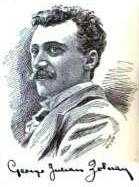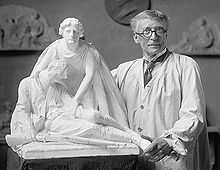George Julian Zolnay
| George Julian Zolnay (Gyula Zsolnay) | |
|---|---|
 | |
| Born | July 4, 1863 |
| Died | May 1, 1949 (aged 85) |
| Nationality | Romanian, American |
| Education | Karl Storck, William-Adolphe Bouguereau, Alexandre Falguière, Edmund von Hellmer, Carl Kundmann |
| Known for | sculpture |
George Julian Zolnay (Gyula Zsolnay) (July 4, 1863 - May 1, 1949) was a Hungarian and American sculptor called the "sculptor of the Confederacy".[1][2]
Early years
Zolnay was born on July 4, 1863[3] to Ignác (Ignatius) and Carolina Vagán Zsolnay. By 1849 his father, co-owner of the famed Zsolnay Porcelaine Manufacturer, had sold his interest and moved from Pécs, Kingdom of Hungary to Bucharest, Kingdom of Romania. Ignác served with General Józef Bem during the 1848 Hungarian War of Independence. Zolnay's birthplace is variously given as being either Bucharest[4][5][6][7][8] or Pécs, Hungary.[9] He grew up in Bucharest, attending the Saint Sava National College.[10] As George's talents in the arts were noticed in his childhood, he initially wanted to become a violinist, attaining a scholarship at the Music and Drama Conservatory; his father's disapproval kept him from violin, but he did learn to appreciate art. At age twenty he assumed a brief career as a cadet in the Romanian cavalry regiments, where he modelled many military objects and individuals. At his father's wishes, he entered the civil service upon leaving the military, but decided to learn sculpting on the side. His father finally impressed by one of his sculptures, Zolnay studied and graduated from the Royal Art Academy of Bucharest where he learned under Karl Stork.[11] He then went to Paris, France to study under William-Adolphe Bouguereau and Alexandre Falguière, as then to the Imperial Academy of Fine Arts of Vienna where he studied under Edmund von Hellmer and Carl Kundmann,[12] and received a Grand Prix for his work. His high ranking at Vienna gave him a grant for his own art studio, and a cash allowance.[13][14][15]
Move to the United States

A scion of the distinguished Zsolnay family of the city of Pécs, Hungary, where their internationally famous ceramics works thrives to this very day, Zolnay came to the United States attend the Columbian Exposition in 1893 at the behest of the U.S. consul-general to Vienna. Already enjoying considerable acclaim in Europe, Zolnay had no difficulties in adjusting to life in America. He intended to return home, but became "enamored" with the United States, and chose New York City for his new home in 1894, eventually achieving American citizenship. In 1895 Zolnay was "employed to make models for the ornamentation" for the Pantheon building created for the Tennessee Centennial Exposition in 1897. [16] He became a favorite sculptor of Southerners in 1897 after he sculpted a statue of Sam Davis, a Confederate spy who was executed; as no pictures of Davis survived, Zolnay based the likeness on Davis' relatives.[17][18] Zolnay's numerous creations, scattered throughout the South, earned him the sobriquet "Sculptor of the Confederacy." Among his most memorable works are memorials to Confederate President Jefferson Davis and his daughter Winnie, affectionately known as the "Daughter of the South."
Zolnay later served as the president of the St. Louis Plastic Arts Association and director of the Chicago School of Fine Arts. In 1903 Zolnay was appointed the director of the art department of the Louisiana Purchase Exposition and in 1909 he became the director of the Art Institute at University City Missouri. He would eventually decide to move to New York City. Zolnay was one of the eight men led by Charles DeKay who founded the National Arts Club,[19] becoming its first vice-president.[20] He was also the president of the Saint Louis Plastic Artists Association and director of the Chicago School of Fine Arts.[21]

He received renown for his work for the Chicago World's Fair. At the University of Virginia he designed the pediment on an academic building, and crafted a bust of Edgar Allan Poe. He became active in Missouri, becoming the art department director of the Louisiana Purchase Exposition in 1903, and in 1909 he became the director of the Art Institute at University City, Missouri.[22][23][24]
In 1913 he moved his studios to Washington, D.C.[25] Besided his sculptural activity, he also delivered lectures on Romania, illustrated with traditional Romanian music and by lantern slides, at the Smithsonian Institution[26] and did illustration work for the two volumes of the book The Roumanians and Their Lands[27] issued by the Roumanian Relief Committee of America in 1919.
He married Abbie R. Gillim November 23, 1902.[28]
Legacy
King Carol I of Romania awarded Zolnay the Knight's Cross of the Order of the Crown.[29]
The Zsolnay family have enriched the culture of the city of Pécs and added to its wealth. The artworks of successive generations can be seen everywhere from the facade of old and new houses, on roofs, on sculptures and reliefs, in shop-windows, on commemorative plaques. The sculpture of the Saracen boy decorating the fountain was made by George Zsolnay. His impact in America was even greater. Notable figures he did included a statue of Jefferson Davis at Hollywood Cemetery in Richmond, Virginia,[30] the Sequoyah statue at the National Statuary Hall Collection,[31] (a commission that he inherited from Vinnie Ream after her death. Zolnay worked primarily on the face of the figure He also created the bas relief on Ream's grave monument, located in Arlington Cemetery)[32] the statue of Tudor Vladimirescu in Târgu-Jiu,[33] Romania and a bust of poet Grigore Alexandrescu.[34]
Gallery
-
Zolnay statue at Jefferson Davis' gravesite in Richmond, Virginia.
-

Book cover of The Roumanians and Their Lands
Notes
- ↑ Brent p.1
- ↑ George Julian Zolnay Findagrave.com, Accessed November 12, 2008
- ↑ Enc.Am. p.723
- ↑ Winfield Scott Downs, Who's who in New York (city and State), Published by Lewis Historical Publ. Co, 1947, page 1177
- ↑ The New York Times, Art Notes, September 16, 1901, Wednesday, Page 6; NYtimes.com
- ↑ The New York Times, The Water Colour Club; Aquarelles and Pastels at the Fine Arts Building, November 8, 1901, Wednesday, Page 7; NYtimes.com
- ↑ The New York Times, Art notes, November 22, 1903, Sunday, Page 7
- ↑ Adrian-Silvan Ionescu, Un artist Bucureştean cu stralucită carieră în Statele Unite ale Americii: George Julian Zolnay, in "Fifth International Congress of Romanian Studies", Constanta, Romania, June 25–28, 2007
- ↑ Enc. Am. snippet from p. 723
- ↑ Winfield Scott Downs, Who's who in New York (city and State), Published by Lewis Historical Publ. Co, 1947, page 1177
- ↑ S.C.I.A. p.349
- ↑ S.C.I.A. p.349
- ↑ Cyclopedia p.372
- ↑ Wright p.39
- ↑ U of V, p.83
- ↑ Creighton, Wilbur F., ‘’The Parthenon In Nashville: From a personal viewpoint, 1968, self published p.21-22
- ↑ Cyclopedia p.373
- ↑ Enc.Am. p.723
- ↑ The New York Times, George J. Zoln/n, a Noted Sculptor; Co-Founder of National Arts Club Is Dead at 8S, May 2, 1949, Monda, Section: Books, Page 25; NYtimes.com
- ↑ S.C.I.A. p.349
- ↑ S.C.I.A. p.349
- ↑ U of V, pp.65, 66, 83
- ↑ Enc.Am. p.723
- ↑ Wright p.39
- ↑ Enc.Am. p.724
- ↑ Annual Report of the Board of Regents of the Smithsonian Institution, By Report of the U.S. National Museum, 1919
- ↑ Stoica, Vasile (editor), The Roumains and Their Lands I: The Roumanian Question and The Roumanians and Their Lands II: The Roumanian Nation and the Roumanian Kingdom, Pittsburgh Printing Co., Pittsburgh, 1919; Gusbooks.com
- ↑ The New York Times, A Sculptor's Romance; George J. Zolnay of This City Will Wed Kentucky Girl He Met in Art School Here, November 24, 1902, Monday, Page 1; NYtimes.com
- ↑ Cyclopedia p.373
- ↑ U of V, pp.66,83
- ↑ National Statuary Hall Collection U.S. Capitol Historical Society, Accessed November 12, 2008
- ↑ Sherwood, Glenn V., ‘’Labor of Love: The Life & Art of Vinnie Ream’’, SunShine Press Publications, Hygiene CO, 1997 pp. 323-329.
- ↑ S.C.I.A. p.349
- ↑ S.C.I.A. p.349
References
- The National Cyclopaedia of American Biography. J. T. White company. 1900.
- The Encyclopedia Americana: A Library of Universal Knowledge. Encyclopedia Americana Corp. 1920.
- Brent, Joseph (1997). Confederate Monument in Owensboro NRHP Nomination Form. Kentucky Heritage Commission.
- U of V (1898). The Alumni Bulletin. University of Virginia.
- Wright, John A. (2002). University City, Missouri. Arcadia Publishing. ISBN 0-7385-2006-3.
- Studii şi Cercetări de Istoria Artei. Institutul de Istoria Artei (The Institude of Art History, Romanian Academy). 1956.

